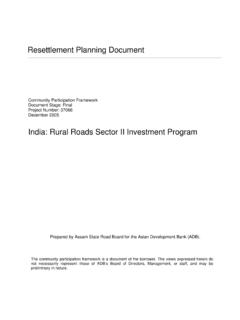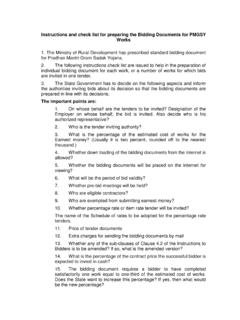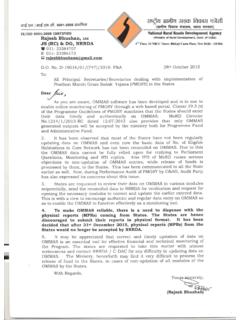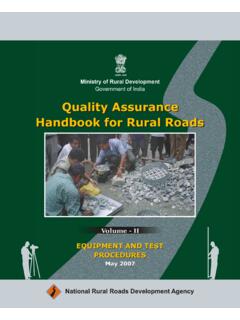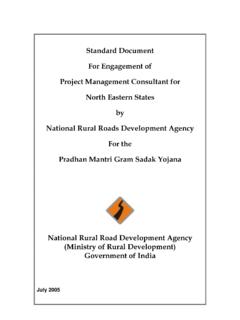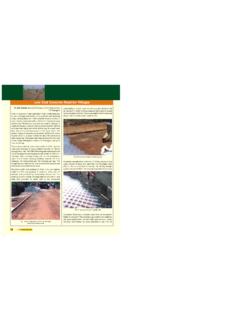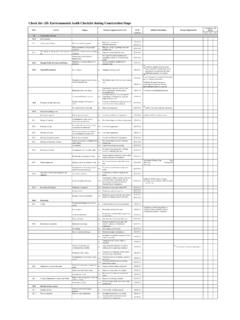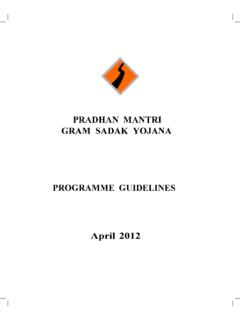Transcription of Cement - PMGSY Home Page
1 15 Cement Stabilized Subgrade, Sub-base and Base IntroductionSubstantial length of the existing low volume rural roads in India is unpaved. Heavy rainfall and floods affect almost all these roads frequently. The unpaved roads are severely damaged due to flood, currents and wave action. This situation needs maintenance of these roads every year/frequently. These adverse effects together with possibly inadequate compaction significantly impair the durability of these roads. The ultimate effect is comparatively low subgrade strength and eventually higher pavement thickness if paved roads are to be constructed. On the basis of this context, some treatment of locally available materials has become necessary for satisfactory and economic construction of roads in these regions.
2 Cement stabilized bases or lime stabilized sub-bases may be provided for the construction of rural roads for low volume/ light traffic. An increasing emphasis has been placed on the use of stabilized pavement materials in recent years. Through the use of stabilizing agents, low-quality materials can be economically upgraded to the extent that these may be effectively utilized in the pavement structure. Stabilized pavement materials are generally incorporated into the pavement structure as base courses and sub-bases. What is Soil- Cement ?Soil- Cement is a highly compacted mixture of soil/aggregate, Cement and water. It is widely used as a low-cost pavement base for roads, residential streets, parking areas, airports, shoulders, and materials-handling and storage areas.
3 Its advantages of great strength and durability combine with low first cost to make it the outstanding value in its field. A thin bituminous surface is usually placed on the soil- Cement to complete the is sometimes called Cement -stabilized base, or Cement -treated aggregate base. Regardless of the name, the principles governing its composition and construction are the Cement StabilisationThe hydrated products of Cement bind the soil particles, the strength developed depending on the concentration of Cement and the intimacy with which the soil particles are mixed with Cement . A high Cement content of the order of 7-10% can produce a hard mass having a 7-day compressive strength of 20 kg/cm2 or more, and this usually goes by the term soil- Cement .
4 However, a smaller proportion of 2-3% Cement can improve the CBR value to more than 25, and the material goes by the term " Cement -modified soil", which can be advantageously used as sub -base/base for rural stabilization is ideally suited for well graded aggregates with a sufficient amount of fines to effectively fill the available voids space and float the coarse aggregate particles. General guidelines for stabilization are that the plasticity index should be less than 30 for sandy materials. For fine-grained soils, soils with more than 50 percent by weight passing 75 m sieve, the general consistency guidelines are that the plasticity index should be less than 20 and the liquid limit (LL) should be less than 40 in order to ensure proper mixing.
5 A more specific general guideline based on the fines content is given in the equation below which defines the upper limit of PI for selecting soil for Cement is appropriate to stabilize gravel soils with not more than 45 percent retained on the no. 4 sieve. The Federal Highway Administration recommends the use of Cement in materials with less than 35 percent passing no. 200 sieve and a plasticity index (PI) less than 20. Based on this system, soils with AASHTO classifications A-2 and A-3 are ideal for stabilization with Cement , but certainly Cement can be successfully used to stabilize A-4 through A-7 soils as well. The Portland Cement Association (PCA) established guidelines to for stabilizing a wide range of soils from gravels to ApplicationGenerally, granular soils free of high concentration of organic matter not greater than 2%, or deleterious salts (sulphate and carbonate not greater than ) are suitable.
6 A useful rule for soil selection is that the plasticity modulus (product of Pl and fraction passing 425 micron sieve) should be less than 250 and that the uniformity coefficient should be greater than Factors Affecting Soil Cement StabilizationDuring soil Cement stabilization the following factors are ) Type of soil: Cement stabilization may be applied in fine or granular soil, however granular is preferable for Cement ) Quantity of Cement : A large amount of Cement is needed for Cement ) Quantity of water: Adequate water is needed for the ) Mixing, compaction and curing: Adequate mixing, compaction and curing is needed for Cement ) Admixtures: Cement has some important admixtures itself which helps them to create a proper bond.
7 These admixtures pay a vital role in case of reaction between Cement and Advantages of Cement Stabilizationa) It is widely ) Cost is relatively ) It is highly ) Soil Cement is quite weather resistant and ) Granular soils with sufficient fines are ideally suited for Cement stabilization as it requires least amount of ) Soil Cement reduces the swelling characteristics of the ) It is commonly used for stabilizing sandy and other low plasticity soils. Cement interacts with the silt and clay fractions and reduces their affinity for Disadvantages of Cement Stabilizationa) Cracks may form in soil ) It requires extra ) The quantity of water must be sufficient for hydration of Cement and making the mixture Selection of StabilizerThe selection of the stabilizer is based on plasticity and particle size distribution of the material to be treated.
8 The appropriate stabilizer can be selected according to the criterion shown in Table 1. Some control over the grading can be achieved by limiting the coefficient of uniformity to a minimum value of 5, however, it should preferably be more than 10. If the coefficient of uniformity lies below 5, the cost of stabilization will be high and the maintenance of cracks in the finished road would be expensive. If the plasticity of soil is high there are usually sufficient clay minerals which can be readily stabilized with lime. Cement is more difficult to mix intimately with plastic material but this problem can be alleviated by pre-treating the soil approximately 2 percent 1: Guide to the Type of Stabilization likely to be EffectiveStabilized MaterialSoil PropertiesMore than 25% passing the mm sieveLess than 25% passing the mm sievePI<1010<PI<20PI>20PI<6 PP<60PI<10PI>10 CementYesYes*YesYesYesLime-YesYesNo*YesL ime- PozzolanaYes-NoYesYes* Requirement of Cement for different types of soilsStabilisation with Cement is resorted to for soils and other locally available materials which do not respond to lime treatment and when comparatively higher and faster development of strength and durability characteristics are needed, especially for waterlogged and high rainfall areas.
9 Granular and sandy soils are most suitable for Cement stabilisation. By way of broad guidelines, the requirements of Cement content for different soil types are as heavy clays/black cotton soils (PI more than 30), two stage stabilization may be adopted the clay is treated with lime in the first stage to reduce plasticity and to facilitate pulverization, whereas in the second stage, the resulting soil is stabilised with 2: Requirements of Cement content for different soil typesSoil TypeRequired Cement ContentSands/Sandy Soils/Soil Gravels3-5 percentSilts/Silty Clays of Low PI (less than 15)4-8 percentClays/Black Cotton Soils8-15 Specifications and Test Requirements for Stabilized General RequirementThe pavement performance of a stabilized road will be largely governed by the gradation and the type of soil/granular material used for the purpose of stabilization.
10 The quality of material to be stabilized should meet the minimum standard set out in specifications. Stabilized layers constructed from such material are likely to perform satisfactory even if, it is affected by carbonation during its life time. Materials which do not comply with the requirements given in the specifications can be stabilised but more additive will be required and the risk from cracking and carbonation will 8increase. The strength of stabilised materials can be evaluated many ways, of which most popular are the Unconfined Compressive Strength (UCS) test and the California Bearing Ratio (CBR) Stabilization with Requirement for soil modification/subgrade improvementCement stabilised materials can be used for soil modification or improvement of subgrade soil.
